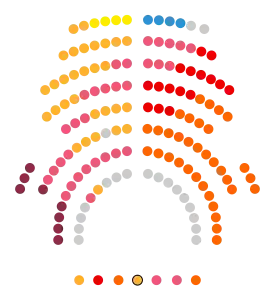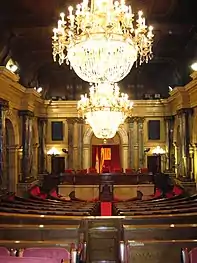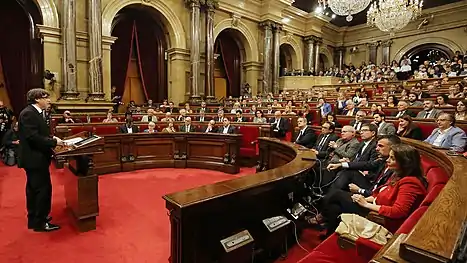Parliament of Catalonia
The Parliament of Catalonia (Catalan: Parlament de Catalunya, IPA: [pəɾləˈmen də kətəˈluɲə]; Spanish: Parlamento de Cataluña; Occitan: Parlament de Catalonha) is the unicameral legislature of the autonomous community of Catalonia, Spain. It is formed by 135 deputies (diputats/deputats/diputados), who are elected every four years or after extraordinary dissolution, chosen by universal suffrage in lists with four constituencies, the Catalan provinces. The Parliament building is located in Ciutadella Park, Barcelona.
Parliament of Catalonia | |
|---|---|
| 12th Parliament | |
 | |
| Type | |
| Type | |
| History | |
| Founded | 1932 |
| Preceded by | Catalan Courts (pre-1714) |
| Leadership | |
| Structure | |
| Seats | 135 |
 | |
Political groups | Government (61)[1][2]
Opposition (69) |
| Elections | |
| Party-list proportional representation | |
Last election | 21 December 2017 |
Next election | 14 February 2021 |
| Meeting place | |
 | |
| Palau del Parlament de Catalunya, Parc de la Ciutadella, Barcelona. | |
| Website | |
| www.parlament.cat | |
 |
|---|
| This article is part of a series on the politics and government of Catalonia |
The most recent parliamentary elections were held on 21 December 2017. Following the 2015 Catalan regional election and the disputed[3] October 1st independence referendum results, the Parliament of Catalonia unilaterally declared independence from Spain on 27 October 2017 with a vote of 70–10, and purported to form the Catalan Republic. The remaining 55 members abstained or boycotted the vote, disagreeing with the independence movement. In response, Spanish Prime Minister Mariano Rajoy dissolved the Parliament and called for a snap regional election.[4]
History
Catalan Courts
The first representative and legislative bodies in Catalonia were the Count's Court (Cort Comtal) of Barcelona, modelling after the Frankish Curia Regis, and the Peace and Truce of God Assemblies (Assemblees de Pau i Treva), of which the earliest record dates from 1027. The last ones were originally ad hoc, local meetings convened by the clergy (Oliba, Bishop of Vic, who died in 1046, was a notable instigator) but progressively became subsumed into the court of the Counts of Barcelona. The first Catalan legal code, the Usatges de Barcelona, was promulgated by Count Ramon Berenguer I based on the decisions of these assemblies.
Although the Counts of Barcelona, had greatly extended the territory under their control, their financial and military power was quite limited, due to the impact of the Feudal revolution during the regency of countess Ermesinde of Carcassonne (1018-1044). Their personal resources were particularly insufficient in periods of economic crisis or military expansion, of which they were many from the twelfth to the fifteenth centuries. The need to secure troops and revenue led to the steady expansion of the Count's Court (Royal Court after the dynasic union of Barcelona and the Kingdom of Aragon, creating the Crown of Aragon) and a formalisation of its procedures. It came to be referred to as the Cort General de Catalunya or Corts catalanes (General Court of Catalonia or Catalan Courts), and was endowed with formal procedures, effectively written constitutions, by King Peter III of Aragon in 1283, making this institution the policemaking and legislative body of the Principality of Catalonia.
The Corts Catalanes were composed of Three Estates (Tres Braços), representing the clergy, the feudal nobles and the citizens of Royal towns such as Barcelona or Girona. Inhabitants of feudal towns (such as Cardona) were not represented, except by their overlords. The main function of the Corts was legislative, either in approving laws proposed by the King Peter III of Aragon (Constitucions) or at their own initiative (capítols de cort). Although the Catalan Courts met at irregular intervals, it also formally approved the acts of the between the King and their sessions (known as pragmàtiques) and, from 1359, established a permanent delegation to oversee the Crown (the Deputation of the General, forerunner of the Generalitat de Catalunya). The Catalan Courts, as well as the other institutions of the Principality and the administrative use of Catalan language, were abolished by the Nueva Planta decrees in 1716 after the House of Bourbon, supported by the Crown of Castille, defeated the Habsburg pretender to throne, which was backed by the remnants of the Crown of Aragon in the War of the Spanish Succession.
Modern history
There were attempts from late 19th century to restore an autonomous system of representation for Catalonia. The Manresa Bases (1892) proposed the creation of new Catalan Courts, largely modeled on the original ones. On the other hand, republican federalists and left-wing Catalan nationalists made their own proposals of a liberal and democratic Catalan assembly. The first achievement of Catalan nationalism (led at that time by the Regionalist League), the Commonwealth of Catalonia (1914–25), was an institution composed by the provincial councils (diputaciones) of Barcelona, Girona, Lleida and Tarragona, which included a general assembly made up by representatives from the four provinces, but lacking legislative powers. In 1919, the Commonwealth redacted a project of Statute of Autonomy for Catalonia in which included a bicameral parliament, however, the law wasn't implemented. the Assembly and the Commonwealth itself were disbanded and outlawed by Miguel Primo de Rivera's dictatorship in 1925.[5]
Following a brief proclamation of the Catalan Republic on 14 April 1931 and the provisional establishment of the Generalitat as a Catalan government within the new Spanish Republic, the first Statute of Autonomy of Catalonia was approved by the Spanish Parliament in September 1932, recognizing Catalan self-government and establishing a separate Parliament of Catalonia as the legislative branch of the Generalitat, being elected on 20 November 1932. This first legislature was control by the Republican Left of Catalonia (Esquerra Republicana de Catalunya, ERC), which won the absolute majority of seats, while the conservative Regionalist League, almost hegemonic in Catalonia during the reign of Alfonso XIII, reached the second place but far from the Republican Left.[6] Lluís Companys was appointed the first president of the Parliament. The Parliament appointed the ERC leader, Francesc Macià, as president of the Generalitat and, right after the election, the institution began to pass a progressive legislation in different areas, such as health, culture and civil law, but the institution was suspended between 1934 and 1936 when the Government of Catalonia attempted to create a Catalan State after, among other reasons, a bill to change the taxing of farmers was rejected by the Constitutional Court. The unilateral declaration of sovereignty lasted 10 hours. The Statute of Autonomy was restored in February 1936 after the victory of Popular Front in the Spanish election, and abolished by Generalissimo Francisco Franco in 1938 during the Spanish Civil War. The Parliament of Catalonia, like the rest of the institutions of the Generalitat, went to exile in 1939.
After the death of Franco in 1975 and during the Spanish transition to democracy the Generalitat came back from exile in 1977. In 1979, the new Statute of Autonomy of Catalonia recognized the restoration of the Parliament. The first legislature of the current Parliament of Catalonia was elected on 20 March 1980, 48 years after the first election in 1932.[7] Convergència i Unió (CiU) a center-right Catalan nationalist electoral coalition won the plurality of seats, giving the Catalan presidency to its leader Jordi Pujol, a position he would hold until 2003.
Functions
The definition and functions of the Parliament of Catalonia are defined by the Title II, Chapter I of the Statute of Autonomy. According to the Statute, the Parliament:[8]
- Elects the President of the Generalitat de Catalunya.
- Pass the Catalan legislation in the business of its competence.
- Pass the Budget of the Autonomous Community of Catalonia.
- Controls the action of the Government of Catalonia and the autonomous agencies, public companies and all other bodies answerable to it.
- Elects the Síndic de Greuges (ombudsman).
- Elects eight senators who represent Catalonia in the Senate of Spain.
- Elaborates bills to present them to the Bureau of the Congress of Deputies and appoints the deputies of the Parliament in charge of defending them.
- Requests the adoption of bills from the Government of the State.
- Requests to the State the transfer or delegation of powers and the attribution of powers within the framework of article 150 of the Constitution.
- Appeals of unconstitutionality before the Constitutional Court and in other constitutional proceedings, in accordance with the provisions of the Organic Law of the Constitutional Court.
- Exercises other functions attributed to it by the Statute and the laws.
Gallery
- Parliament of Catalonia gallery
 Facade of the Palace of Parliament
Facade of the Palace of Parliament Session chamber of the Palace of Parliament
Session chamber of the Palace of Parliament Catalan expresident Carles Puigdemont gives a speech at the Parliament of Catalonia on 10 October 2017
Catalan expresident Carles Puigdemont gives a speech at the Parliament of Catalonia on 10 October 2017
References
- "Resultats electorals". Parlament de Catalunya (in Catalan). 17 January 2018. Retrieved 5 March 2019.
- "Distribució d'escons". Parlament de Catalunya (in Catalan). Retrieved 5 March 2019.
- Carranco, Rebeca (17 October 2017). "Spain's Constitutional Court strikes down Catalan referendum law". El Pais. Retrieved 17 February 2018.
- Ponce de León, Rodrigo (27 October 2017). "Rajoy cesa a Puigdemont y su Govern y convoca elecciones para el 21 de diciembre". eldiario.es (in Spanish). Retrieved 27 October 2017.
- "Mancomunitat de Catalunya" [Commonwealth of Catalonia]. Encyclopedia Catalana (in Catalan). Grup Enciclopèdia Catalana. Retrieved 15 October 2012.
- "Hoy se elige el segundo Parlamento democrático de Cataluña". El País (in Spanish). 20 March 1980. Retrieved 27 December 2019.
- "Title II of the Statute of Autonomy of Catalonia". gencat.cat. Retrieved 22 January 2021.
External links
| Wikimedia Commons has media related to Parliament of Catalonia. |
- Official website (multilingual, mostly in Catalan)
- "Parlament de Catalunya – Història" (in Catalan). Archived from the original on 22 February 2013. Retrieved 5 January 2007.